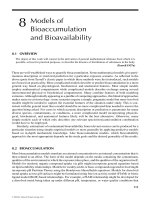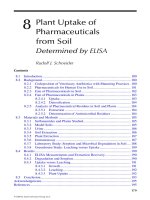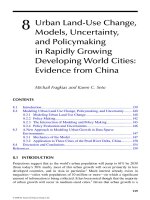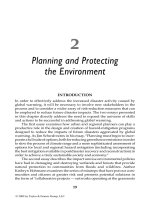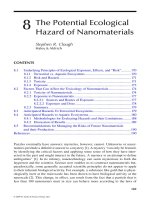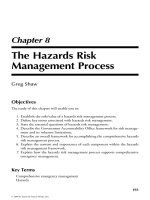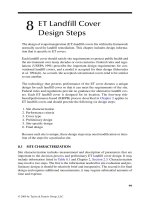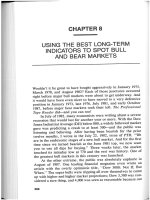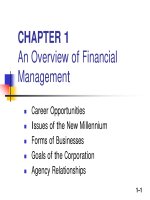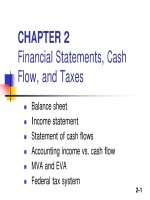Slide Financial Management - Chapter 8 potx
Bạn đang xem bản rút gọn của tài liệu. Xem và tải ngay bản đầy đủ của tài liệu tại đây (193.65 KB, 39 trang )
8-1
CHAPTER 8
Stocks and Their Valuation
Features of common stock
Determining common stock values
Efficient markets
Preferred stock
8-2
Facts about common stock
Represents ownership
Ownership implies control
Stockholders elect directors
Directors elect management
Management’s goal: Maximize the
stock price
8-3
Social/Ethical Question
Should management be equally concerned
about employees, customers, suppliers,
and “the public,” or just the stockholders?
In an enterprise economy, management
should work for stockholders subject to
constraints (environmental, fair hiring,
etc.) and competition.
8-4
Types of stock market
transactions
Secondary market
Primary market
Initial public offering market
(“going public”)
8-5
Different approaches for
valuing common stock
Dividend growth model
Corporate value model
Using the multiples of comparable
firms
8-6
Dividend growth model
Value of a stock is the present value of the
future dividends expected to be generated by
the stock.
∞
∞
+
++
+
+
+
+
+
=
)k(1
D
)k(1
D
)k(1
D
)k(1
D
P
s
3
s
3
2
s
2
1
s
1
0
^
8-7
Constant growth stock
A stock whose dividends are expected to
grow forever at a constant rate, g.
D
1
= D
0
(1+g)
1
D
2
= D
0
(1+g)
2
D
t
= D
0
(1+g)
t
If g is constant, the dividend growth formula
converges to:
g -k
D
g -k
g)(1D
P
s
1
s
0
0
^
=
+
=
8-8
Future dividends and their
present values
t
0t
) g 1 ( DD +=
t
t
t
) k 1 (
D
PVD
+
=
t0
PVDP
∑
=
$
0.25
Years (t)
0
8-9
What happens if g > k
s
?
If g > k
s
, the constant growth formula
leads to a negative stock price, which
does not make sense.
The constant growth model can only be
used if:
k
s
> g
g is expected to be constant forever
8-10
If k
RF
= 7%, k
M
= 12%, and β
= 1.2,
what is the required rate of return on
the firm’s stock?
Use the SML to calculate the required
rate of return (k
s
):
k
s
= k
RF
+ (k
M
–k
RF
)β
= 7% + (12% -
7%)1.2
= 13%
8-11
If D
0
= $2 and g is a constant 6%,
find the expected dividend stream for
the next 3 years, and their PVs.
1.8761
1.7599
D
0
= 2.00
1.6509
k
s
= 13%
g = 6%
0 1
2.247
2
2.382
3
2.12
8-12
What is the stock’s market value?
Using the constant growth model:
$30.29
0.07
$2.12
0.06 - 0.13
$2.12
g - k
D
P
s
0
=
=
==
1
8-13
What is the expected market price
of the stock, one year from now?
D
1
will have been paid out already. So,
P
1
is the present value (as of year 1) of
D
2
, D
3
, D
4
, etc.
Could also find expected P
1
as:
$32.10
0.06 - 0.13
$2.247
g - k
D
P
s
2
^
1
=
==
$32.10 (1.06) P P
0
^
1
==
8-14
What is the expected dividend yield,
capital gains yield, and total return
during the first year?
Dividend yield
= D
1
/ P
0
= $2.12 / $30.29 = 7.0%
Capital gains yield
= (P
1
–P
0
) / P
0
= ($32.10 -
$30.29) / $30.29 = 6.0%
Total return (k
s
)
= Dividend Yield + Capital Gains Yield
= 7.0% + 6.0% = 13.0%
8-15
What would the expected price
today be, if g = 0?
The dividend stream would be a
perpetuity.
2.00 2.002.00
0 1 2 3
k
s
= 13%
$15.38
0.13
$2.00
k
PMT
P
^
0
===
8-16
Supernormal growth:
What if g = 30% for 3 years before
achieving long-run growth of 6%?
Can no longer use just the constant growth
model to find stock value.
However, the growth does become
constant after 3 years.
8-17
Valuing common stock with
nonconstant growth
k
s
= 13%
g = 30% g = 30% g = 30% g = 6%
P
=
0.06
$66.54
3
4.658
0.13
−
=
2.301
2.647
3.045
46.114
54.107 = P
0
^
0 1 2 3 4
D
0
= 2.00 2.600 3.380 4.394
4.658
8-18
Find expected dividend and capital gains
yields during the first and fourth years.
Dividend yield (first year)
= $2.60 / $54.11 = 4.81%
Capital gains yield (first year)
= 13.00% -
4.81% = 8.19%
During nonconstant growth, dividend yield
and capital gains yield are not constant,
and capital gains yield ≠ g.
After t = 3, the stock has constant growth
and dividend yield = 7%, while capital
gains yield = 6%.
8-19
Nonconstant growth:
What if g = 0% for 3 years before long-
run growth of 6%?
k
s
= 13%
g = 0% g = 0% g = 0% g = 6%
0.06
$30.29P
3
2.12
0.13
=
−
=
1.77
1.57
1.39
20.99
25.72 = P
0
^
0 1 2 3 4
D
0
= 2.00 2.00 2.00 2.00
2.12
8-20
Find expected dividend and capital gains
yields during the first and fourth years.
Dividend yield (first year)
= $2.00 / $25.72 = 7.78%
Capital gains yield (first year)
= 13.00% -
7.78% = 5.22%
After t = 3, the stock has constant
growth and dividend yield = 7%,
while capital gains yield = 6%.
8-21
If the stock was expected to have
negative growth (g = -6%), would anyone
buy the stock, and what is its value?
The firm still has earnings and pays
dividends, even though they may be
declining, they still have value.
$9.89
0.19
$1.88
(-0.06) - 0.13
(0.94) $2.00
g - k
)g1(D
g - k
D
P
s
0
s
1
^
0
===
+
==
8-22
Find expected annual dividend and
capital gains yields.
Capital gains yield
= g = -6.00%
Dividend yield
= 13.00% -
(-6.00%) = 19.00%
Since the stock is experiencing constant
growth, dividend yield and capital gains
yield are constant. Dividend yield is
sufficiently large (19%) to offset a negative
capital gains.
8-23
Corporate value model
Also called the free cash flow method.
Suggests the value of the entire firm
equals the present value of the firm’s
free cash flows.
Remember, free cash flow is the firm’s
after-tax operating income less the net
capital investment
FCF = NOPAT – Net capital investment
8-24
Applying the corporate value model
Find the market value (MV) of the firm.
Find PV of firm’s future FCFs
Subtract MV of firm’s debt and preferred stock to
get MV of common stock.
MV of = MV of – MV of debt and
common stock firm preferred
Divide MV of common stock by the number of
shares outstanding to get intrinsic stock price
(value).
P
0
= MV of common stock / # of shares
8-25
Issues regarding the
corporate value model
Often preferred to the dividend growth
model, especially when considering number
of firms that don’t pay dividends or when
dividends are hard to forecast.
Similar to dividend growth model, assumes at
some point free cash flow will grow at a
constant rate.
Terminal value (TV
n
) represents value of firm
at the point that growth becomes constant.
